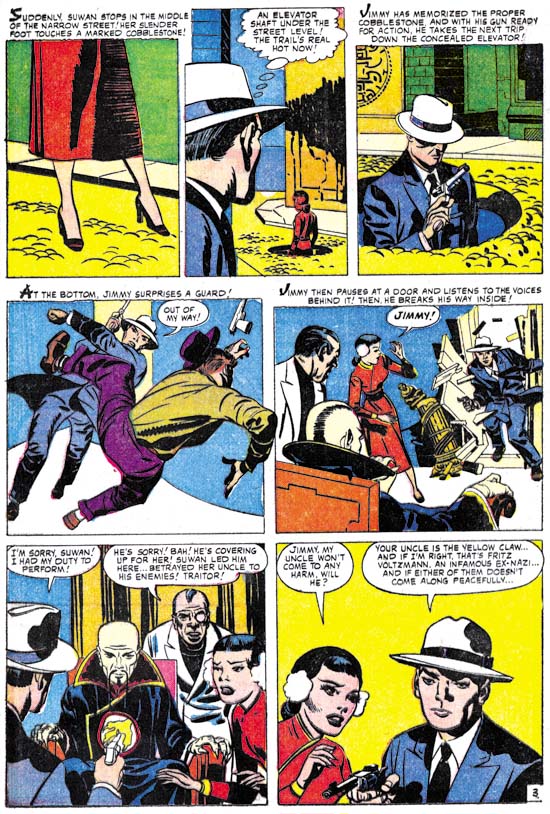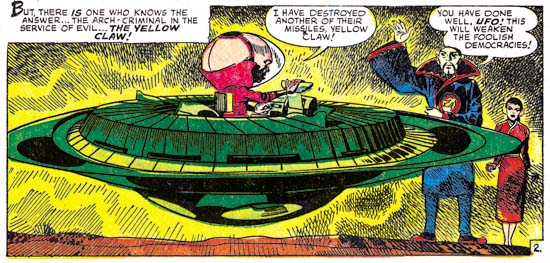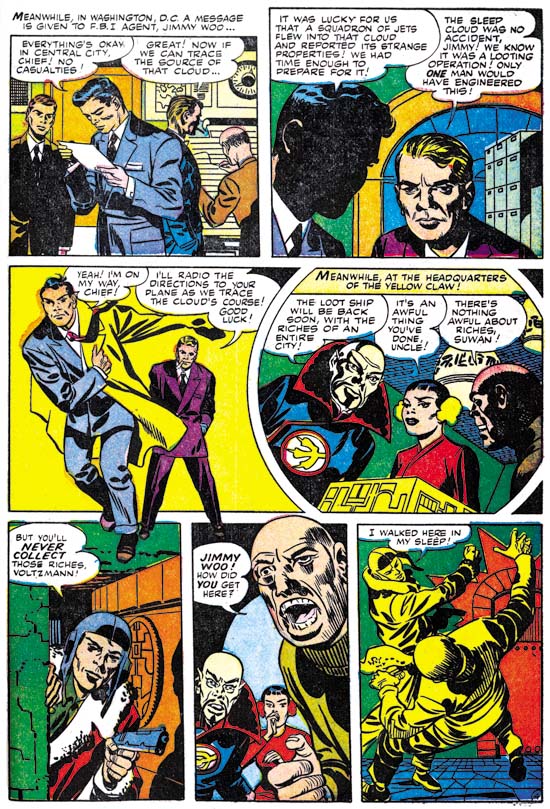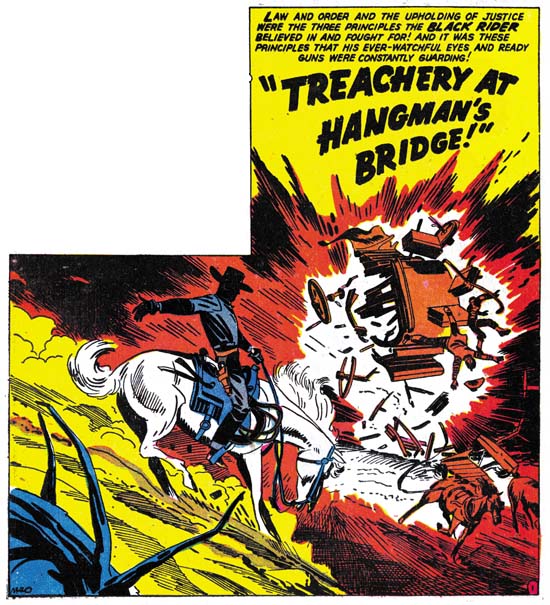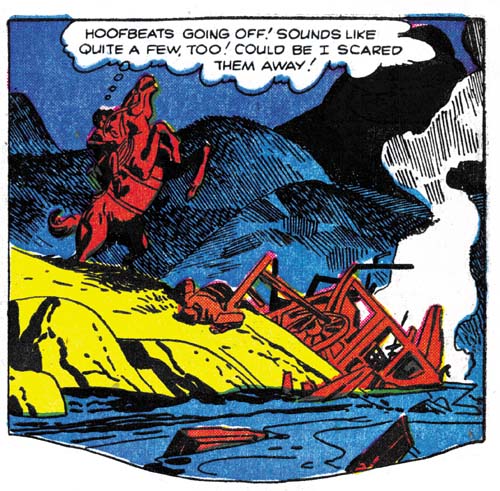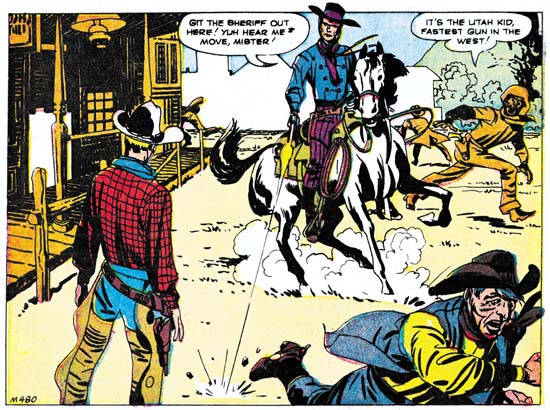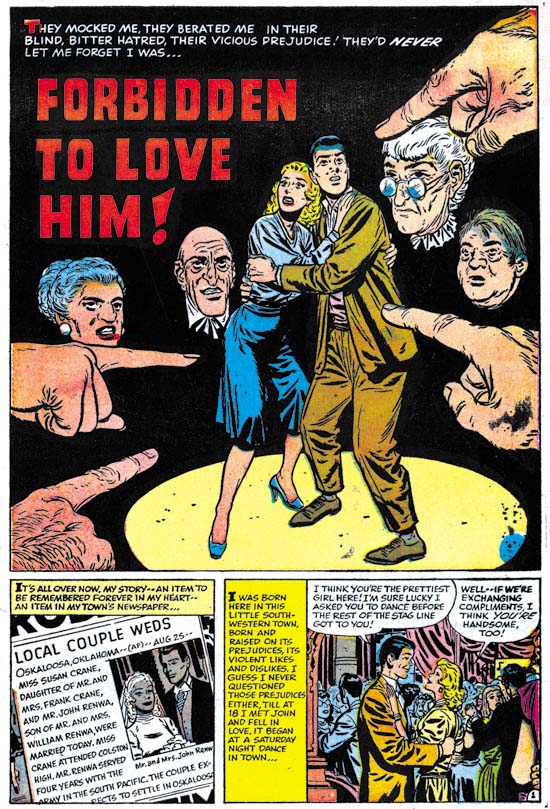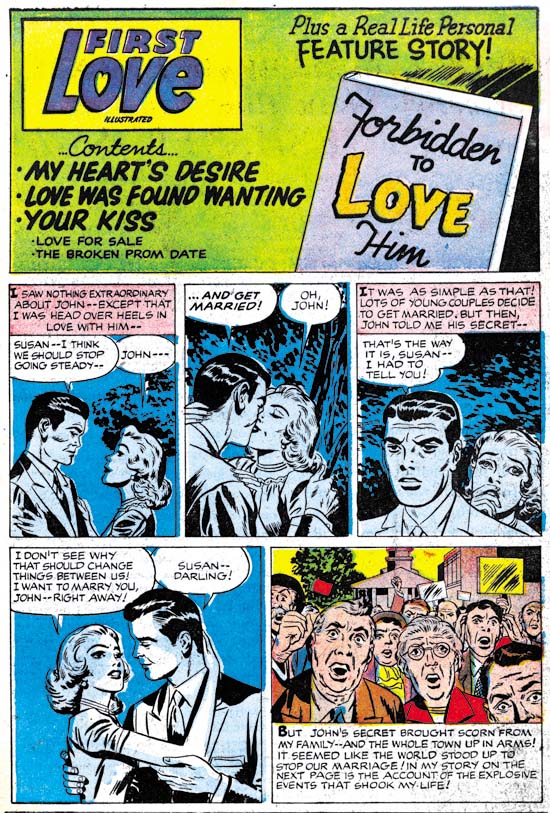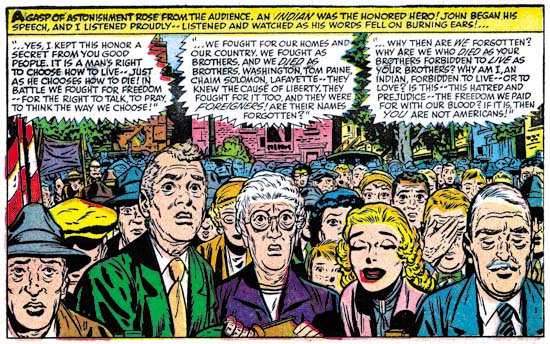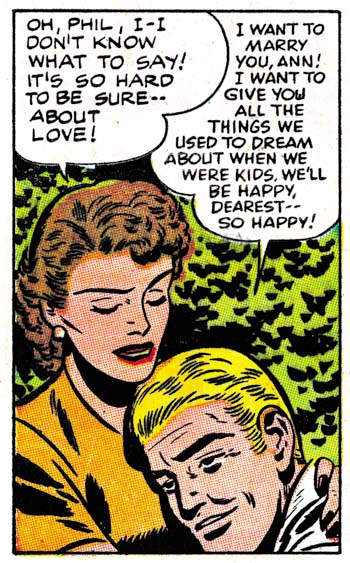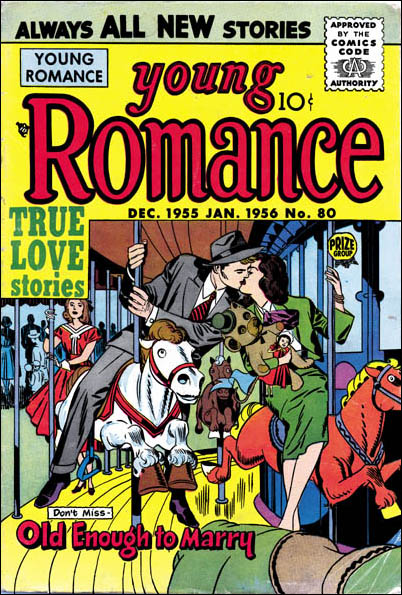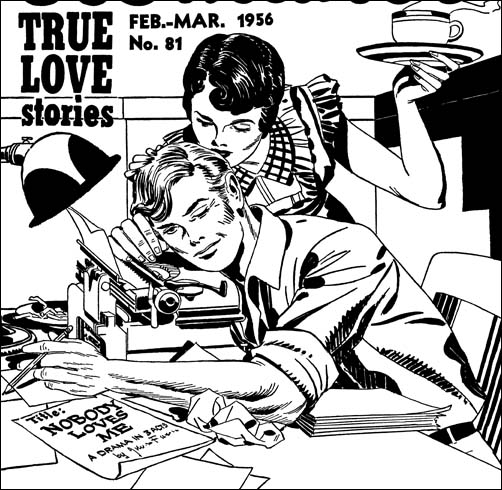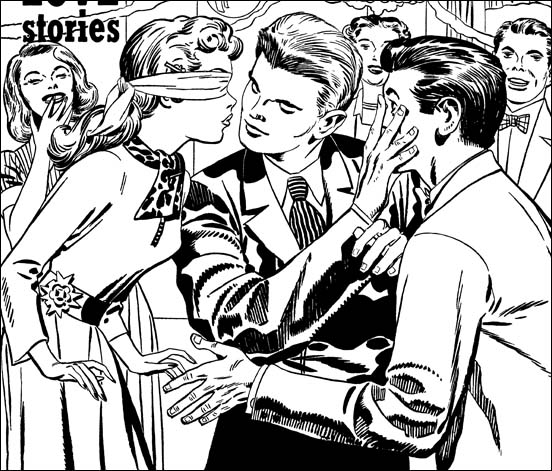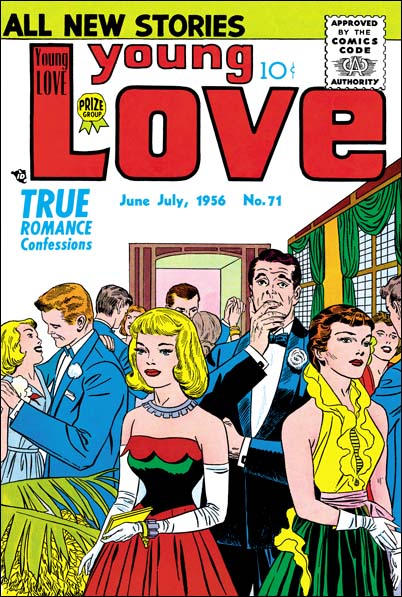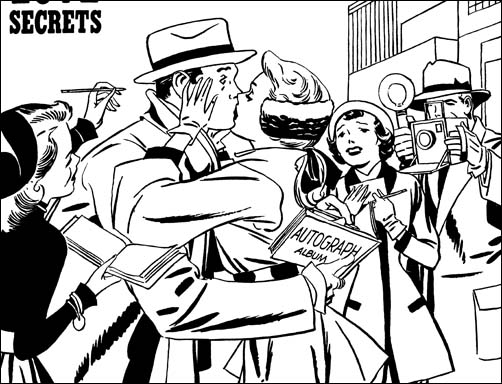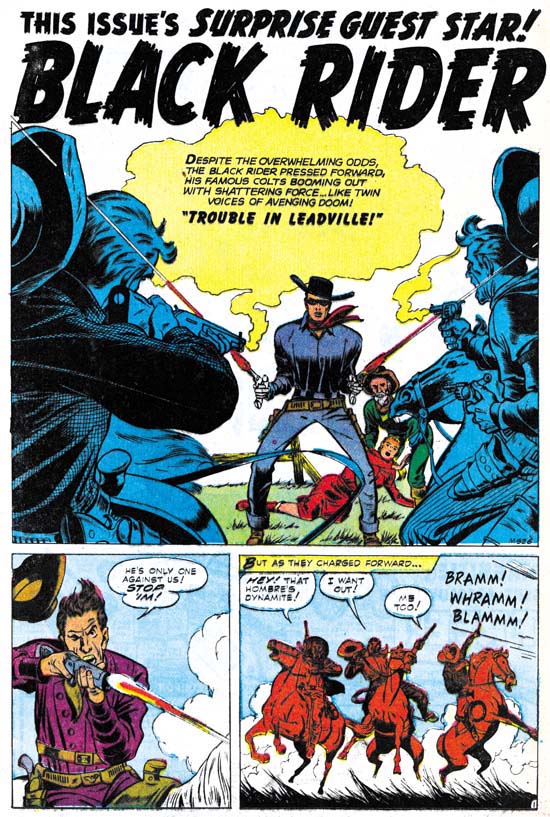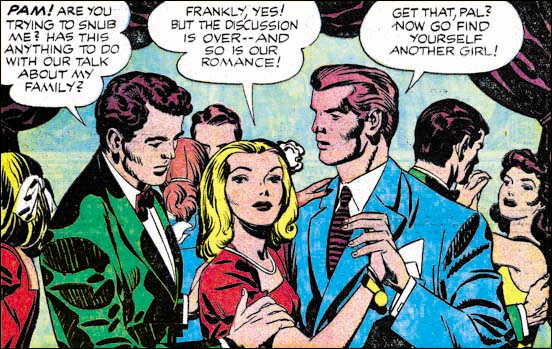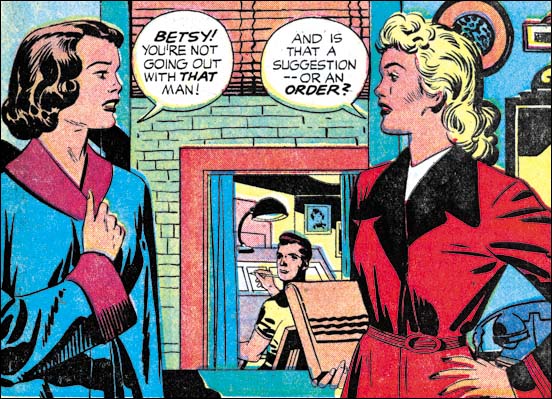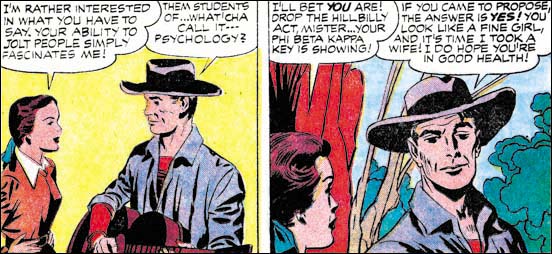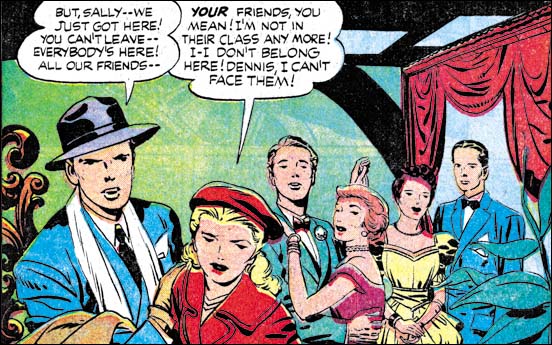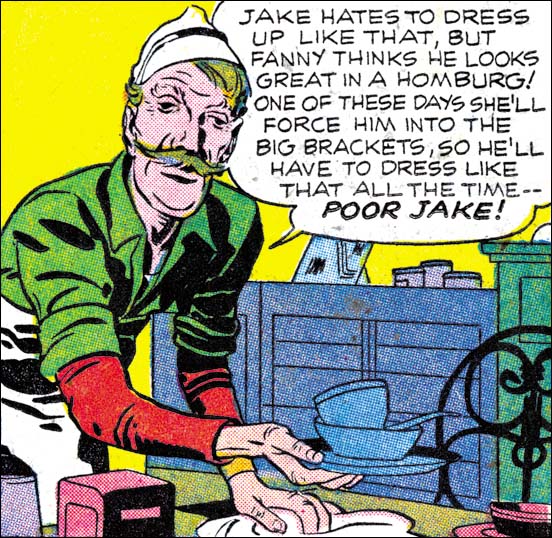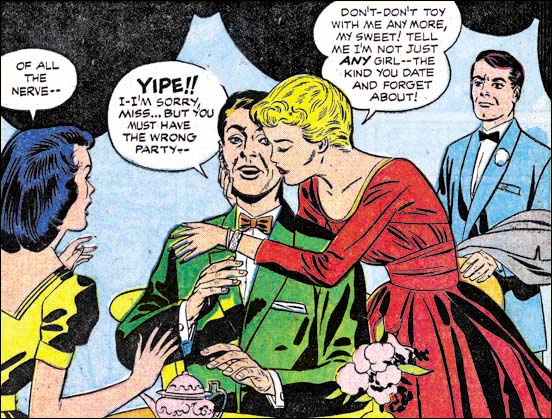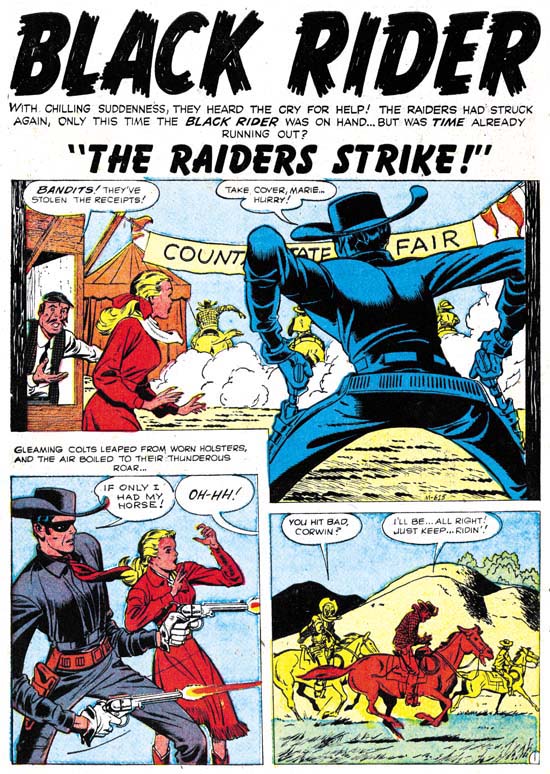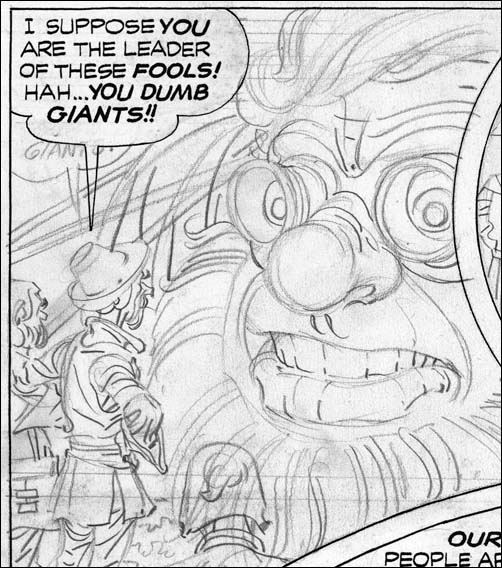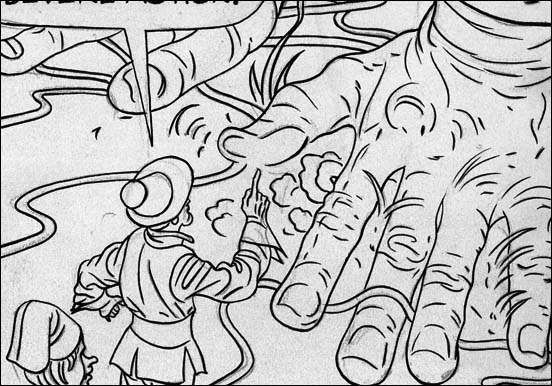While Jack Kirby was almost single handedly penciling all the Prize romance comics (see previous chapter) Joe Simon seems to have been doing some editorial work for Harvey. I say “seems” because I have no firm evidence to indicate when Joe started doing this work. Joe’s collection still includes some proofs of Harvey romance content pages. Also Bill Draut and John Prentice, long time Simon and Kirby artists, both start appearing in the Harvey romances at this time. Perhaps related to Joe’s editorial work, Jack would also provide some covers for Warfront and the romance titles. Harvey would also publish Western Tales (#31 to #33) and Black Cat Mystic (#58 to #60) which appear to be actual Simon and Kirby productions.
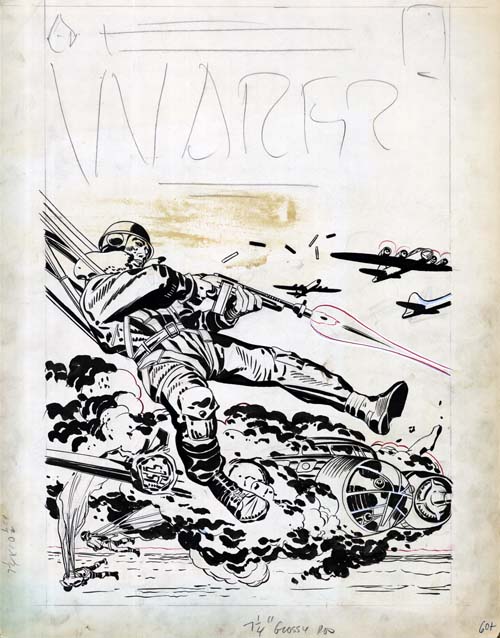
Warfront #28 (January 1956) original art, pencils and inks by Jack Kirby
The inking on this cover is done in typical Studio style manner by Kirby. Not much in the way of picket fences but lots of variants of drop strings. Particularly convincing are the negative folds on the paratrooper’s right lower leg. What is not quite so certain is whether this art was originally meant for the cover of Warfront #28. The plane engulfed in flames was modeled (by no means a close copy) from a panel in “Hot Box”, a story that appeared in Foxhole #2 (December 1954). This suggests the possibility that this art was originally meant to be the cover for Foxhole #2. Certainly the penciling and inking are both good matches for some of the Foxhole covers such as issues #2, #3 or #5. However we saw in chapters 3 and 4 that early in 1956 Jack would still do a typical Studio style inking. With only four months separating the last Foxhole issue from Warfront #28, I am not sure we much we can deduce from the stylistic similarities.
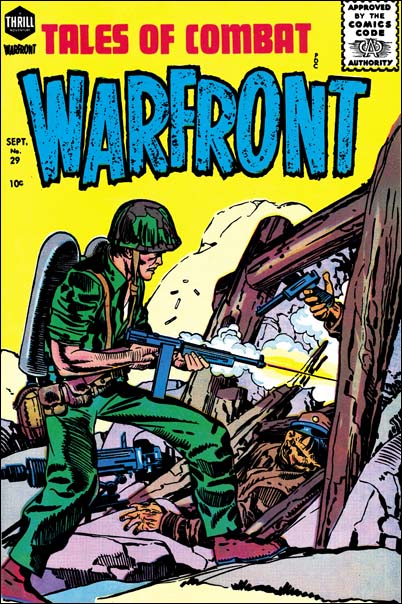
Warfront #29 (July 1956) pencils and inks by Jack Kirby and Joe Simon?
Jack did the pencils and inks for much of the Warfront #29 cover. Excluded is the torso where both the penciling and inking seems to have been done by another hand. I previously discussed this cover in my serial post on the End of Simon and Kirby. There I concluded that originally the man held a flame thrower but had been reworked to avoid problems with the Comic Code. Since Jack did not do the reworking, the most likely candidate would be Joe Simon. The parts I think were inked by Jack were done in typical Studio manner.
The Jack Kirby Checklist, and some comic scholars attribute the cover drawing of Warfront #30 (September 1957) and #34 (September 1957) to Jack. I disagree with those attributions. But as far as I can remember no one has claimed that Kirby did the inking for these covers. Therefore they need not concern us here.
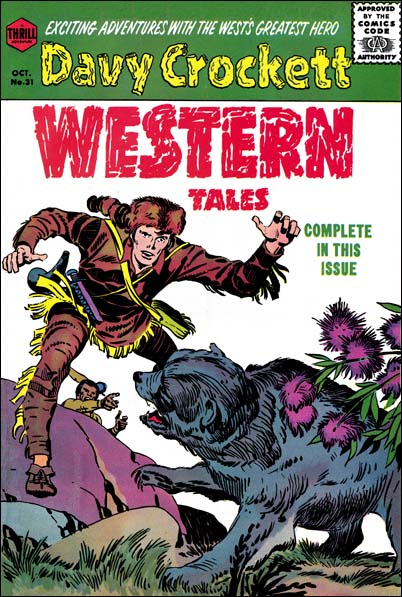
Western Tales #31 (October 1955) pencils and inks by Jack Kirby
With the end of the Mainline/Charlton S&K would want to produce new material to take their place. But what was likely to sell during these troubled times in the comic industry? Well it did not take an expert to figure this out, at that time it must have seemed that all the kids were wearing coon skin hats. Walt Disney had aired “Davy Crockett, King of the Wild Frontier” in three episodes (December 15, 1954, January 26, 1955 and February 23, 1955. The response, at least among young boys, was overwhelming. For comic book publishers, what was especially attractive about Davy Crockett was that he was a historical figure and therefore not subject to copyright or trademark protection.
Probably the only thing unusual about these Western Tales issues was how much Kirby was in them. Actually this really was not too surprising as it was the modus operandi of S&K when launching a new title. Not all of it was new, also included in each issue was a reprint story from Boys’ Ranch. The new art was typical Simon and Kirby and used Studio Style inking. This is what would be expected judging from what we have seen for the Prize romances at that time.
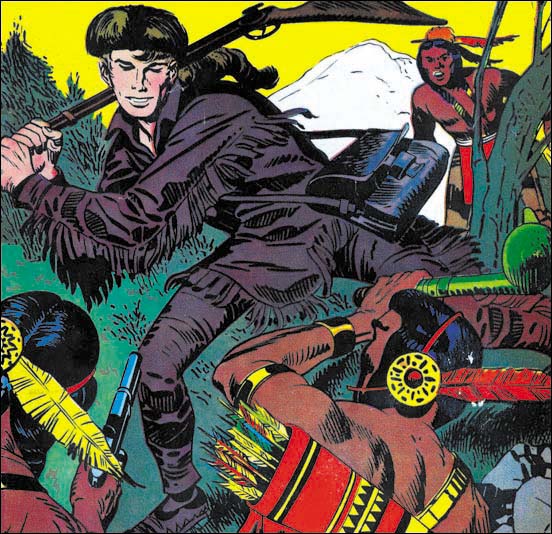
Western Tales #32 (March 1956) pencils and inks by Joe Simon
Although Kirby did pretty much all the new art for Western Tales, I believe the cover for WT #32 was penciled and inked by Joe Simon. A comparison with WT #31 shows that Joe did a pretty good job with the Studio Style. Nice picket fence and drop string work. The spot inking on Davy’s right leg seems a little different then Jacks, particularly the negative folds.
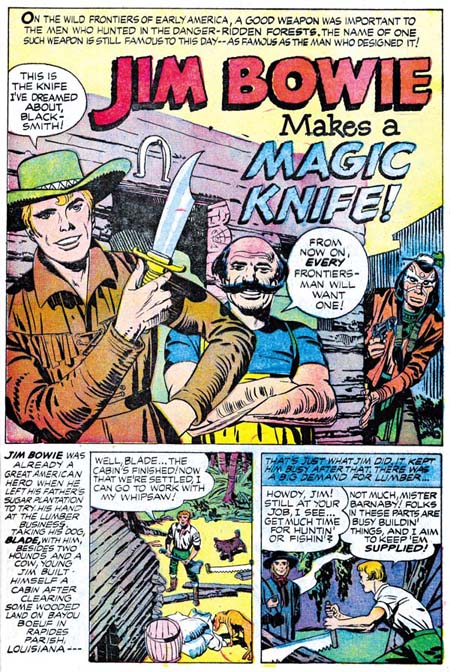
Western Tales #33 (July 1956) “Jim Bowie Makes A Magic Knife” page 1 pencils and inks by Jack Kirby
A comic on Davy Crockett might have seem very topical and free from legal hassles. The only problem was that it was obvious to other publishers as well. By the time WT #31 hit the stands there was already numerous competitors doing Davy Crockett material. Not only that but one of them was Dell who had the Disney franchise and could use a photo cover of Fess Parker, the actor from the Disney TV shows. To avoid the competition, a changed seemed in order. So the new hero for WT #33 was Jim Bowie. There was a television show for Bowie as well, but it did not air until September 7, 1956. Much too late to be any influence on Simon and Kirby. Even the movie “The First Texan” was probably too late as well (June 1956). But S&K were well aware of the Alamo, they included a double page splash on it in an issue of Boys’ Ranch. So Jim Bowie was in all likelihood just an obvious choice for a new hero.
There is a marked similarity of the art in WT #33 as compared to issues #31 and #32. This is a little surprising because by July the Prize romances were showing frequent use of the Austere Style. In WT #33 all the inking continued to use the Studio Style. With the long time between Western Tales issues I cannot help but wonder if the art was done earlier then the July cover date would indicate.
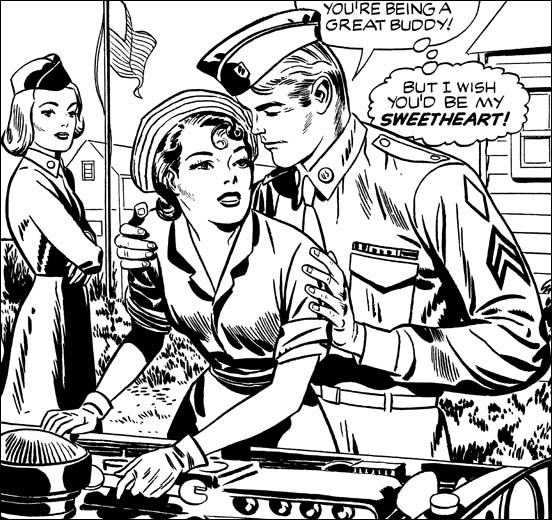
Love Problems and Advice #38 (March 1956) restored line art, pencils and inks by Jack Kirby
As if doing almost all the art for the Prize romance titles was not enough of that genre for Jack, he would also do some of the covers for the Harvey romances. Although Kirby used the Studio Style for Harvey’s Warfront and Western Tales covers, he never used it for the romance covers. None of the covers have picket fences, and even drop strings get limited use. Actually the Harvey covers are not good matches for the Austere Style either. I would give Jack’s Harvey inking a name except there are still some unresolved issues as I will discuss below.
The inking for Love Problems and Advice #38 cover is probably the one I am feel most sure about attributing to Jack Kirby. Although on a whole not in true Studio Style it does have some similarities. The way the modified drop strings are handled is the same as in the Studio Style. The clothing folds are done in a similar manner as well. New, at least for Jack, are the roughly parallel lines that cover some areas. Jack had done something similar, as for instance in the Warfront #28 cover shown above. But for Warfront #28 the lines are bold in keeping with the Studio Style. In Love Problems #38 the lines are finer, although I would still hesitate to describe them as truly fine. There are some areas flooding with black as in the Austere method, but the overall image does not have the lightness typical of that style.
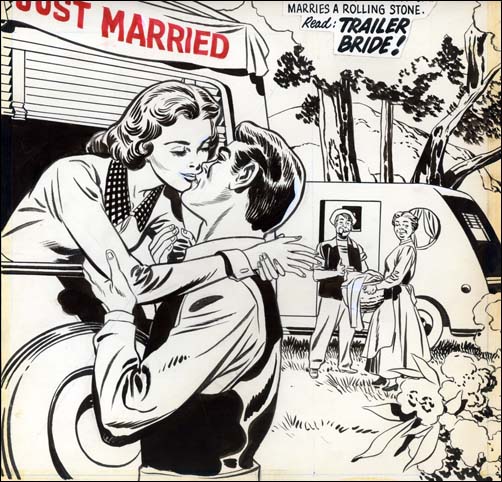
True Bride-To-Be #19 (August 1956) original art, pencils by Jack Kirby inks by Joe Simon
Many, probably most, of the Harvey romance covers were not inked by Kirby. The one from True Brides-To-Be #19 that I show above is a good example of inking by another artist. Jack did indicate the folds for the clothing in the pencils so once again we find a bunching up of folds in the elbow and shoulder regions. The inker has also picked up of Jack’s flooding of ink in certain areas. But the treatment of the blacks on the man’s jacket do look a little unnatural. I am not certain, but the way the elbow folds are handled remind me of some work Simon did later so I attribute the inking of this cover to Joe.
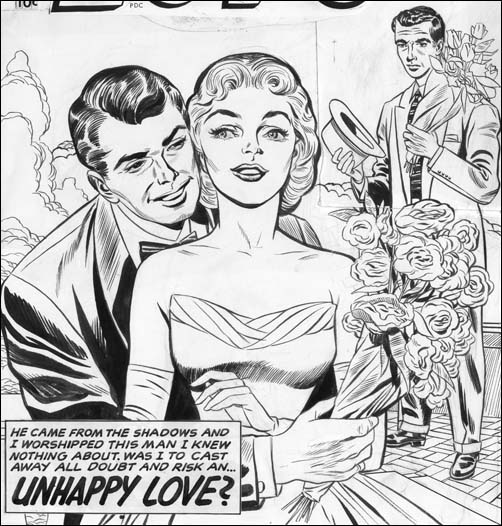
First Love #70 (November 1956) pencils by Jack Kirby inks by Jack Kirby and Bill Draut?
The line inking of the First Love #70 cover remind me of Kirby. The spotting is a more questionable issue. Much of the gray of the image is created by the use of fine parallel lines. These lines are similar to those found in Love Problems #38 only finer. It could very well be that this could reflect the same move to finer brush work that we found on some of the Prize romance covers. That was in fact the conclusion that I previously reached. While reviewing the matter for this serial post I have come to a different opinion. Note the man in the background, he seems to be treated to a different spotting style. That did not bother me before because this man was a late addition. His upper part was done on a piece of paper that was pasted over previous art. The paste has held so the original art is not visible but by using a strong light from behind it looks like his place used to be occupied by the side of a house. Anyway the spotting on the man in the background reminds me of Bill Draut’s work. Bill would sometime use fine parallel lines. Compare the lines on the jacket collar of the man in the front with some of the brush work for an unpublished cover by Bill Draut shown below. Perhaps he was responsible for the spotting of the whole cover. I now think Bill did most of the spotting but I still feel outline inking of the couple were done by Jack.
The story gets more complicated. There may be two hands involved in the spotting. The first one did all the fine work that I described. The second came in later and strengthen certain areas on the man’s arm and in his hair. This was done with a very bold and assured brush. You can still make out an area on the arm where this was done with a sort of coarse picket fence brush work. If Jack was the first inker then I suspect the touch up work was by Joe Simon. The need for such strengthening is more likely seen by someone other then the original artist. If Draut was the initial spotter then Jack probably did the correction.
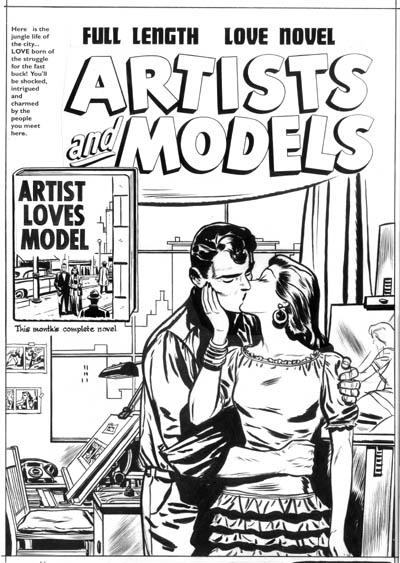
Artists and Models unpublished cover from about December 1954 pencils and inks by Bill Draut
The Black Cat titles present a difficulty to any chronological analysis. Harvey’s support seemed to be lukewarm to publishing Simon and Kirby productions. Four to five months separate the Western Tales issues described above. That was bad, but Black Cat was much worse. Black Cat Mystery #57 is cover dated January 1956, Black Cat Mystic #58 is September of the same year. Black Cat Mystic #59 was not released until a year later (September 1957). With such long periods between releases who can be sure when the art was actually done. I will leave of a discussion of Black Cat Mystic #59 until a future chapter, but we shall see that stylistically BCM #59 was very much like BCM #58.
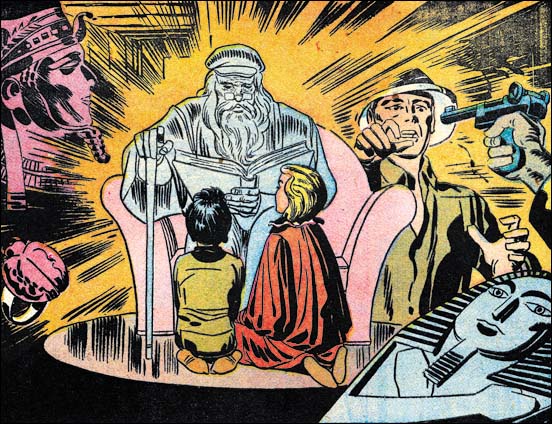
Black Cat Mystic #58 (September 1956) “Read To Us Mr. Zimmer” splash panel from page 1 pencils and inks by Jack Kirby
Jack drew and inked the cover for Black Cat Mystery #57 (January 1956). Considering the cover date it is not surprising that it was done in a typical Studio style, although without the use of picket fence brush work. Similar Studio style inking is found even in Black Cat Mystic #58 despite the late September date as can be seen in the splash panel above.
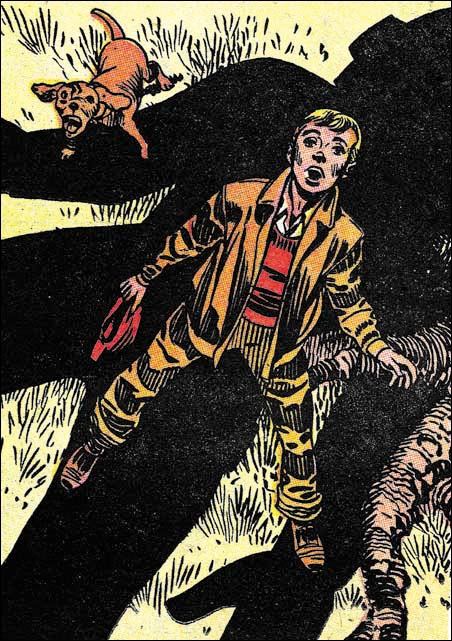
Black Cat Mystic #58 (September 1956) “Gismo” splash panel from page 1 pencils and inks by Jack Kirby
But not too much should be made about the absence of picket fences in the Mr. Zimmer splash. Elsewhere in the comic very typical use of picket fences can be found as for instance the splash to “Gismo”. It is a perfectly good example of typical Studio style brush work.
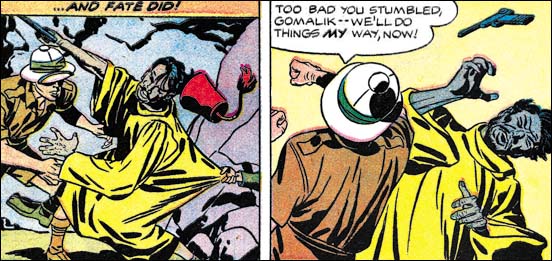
Black Cat Mystic #58 (September 1956) “Read To Us Mr. Zimmer” panels 4 and 5 from page 4 pencils and inks by Jack Kirby
However some of the art for BCM #58 does begin to look like Austere inking, particularly when you get into the story panels. So what should be made about this combination of Studio and Austere style inking? Considering the late date for this title it is surprising that Studio style seems predominant. I suspect that some of the art was create earlier. But since some Austere inking can be found I do not believe the all the art was done right after BCM #57 and then held until Harvey was ready to publish.
Jack Kirby’s Austere Inking, Chapter 1, Introduction
Jack Kirby’s Austere Inking, Chapter 2, Mainline
Jack Kirby’s Austere Inking, Chapter 3, A Lot of Romance
Jack Kirby’s Austere Inking, Chapter 4, Prize Covers
Jack Kirby’s Austere Inking, Chapter 6, Atlas
Jack Kirby’s Austere Inking, Chapter 7, DC
Jack Kirby’s Austere Inking, Chapter 8, More Harvey
Jack Kirby’s Austere Inking, Chapter 9, More Prize
Jack Kirby’s Austere Inking, A Checklist and a Glossary
other post with Kirby inking Kirby:
Strange Tale Indeed
Battleground, Jack Kirby’s Return to Atlas
Captain 3D




